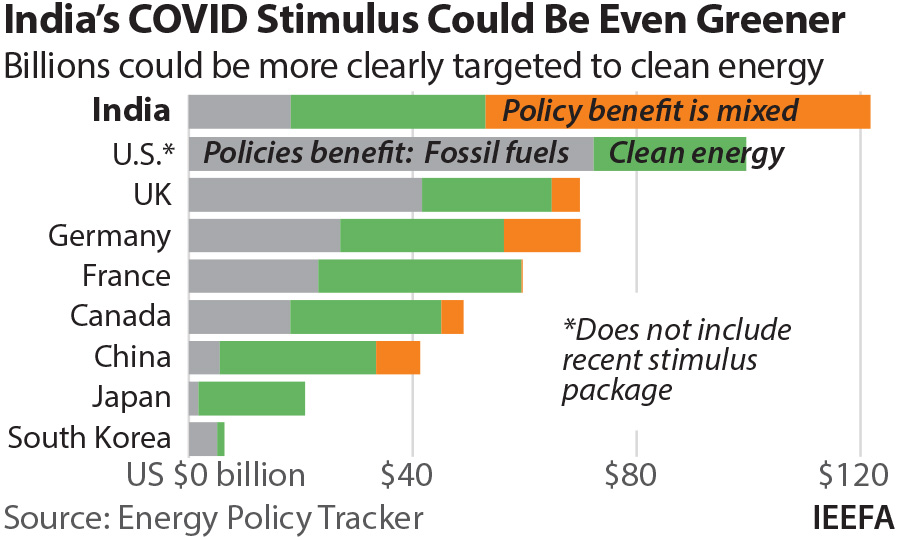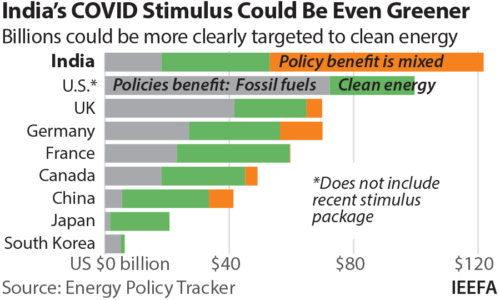IEEFA: India’s $122bn stimulus for energy promotes renewables but lacks clarity in additional funding streams

22 March 2021 (IEEFA India): While India has committed more public money than any other economy to date – at least US$122 billion – to supporting the energy sector since the start of the COVID-19 crisis in early 2020, a new report shows the government’s stimulus is a ‘mixed bag’ for the country’s energy transition.
The Government of India continues to promote a greener recovery by committing US$35 billion (28.5%) of the US$122 billion in energy-related funding to renewables, almost twice the US$18 billion (15%) flowing to fossil fuels.
However, the largest proportion of support for energy by far is being spent on policies categorised as ‘other energy’, some US$69 billion (56.5%), with little public information available on whether this recovery funding is going to policies that promote sustainable energy, or energy types and sectors with high carbon emissions.

In a new joint report called How Green is India’s Stimulus for Economic Recovery?, the Institute for Energy Economics and Financial Analysis (IEEFA) and the International Institute for Sustainable Development (IISD) reviewed energy-related policies from the Energy Policy Tracker (EPT), to determine what India can do to promote a greener economy recovery in 2021.
“According to the EPT, India has committed more public money to the energy sector than any other economy globally since January 2020,” says lead author Vibhuti Garg, IEEFA Energy Economist, Lead India. “We estimate that around 22% of the value of these public money commitments are primarily to deal with the impact of COVID-19 and the rest is to meet the government’s ongoing policy objectives on energy security, air pollution and climate change.”
The Energy Policy Tracker (EPT) is a database developed by the IISD and other organisations that uses official government sources and other publicly available information to track energy-related COVID-19 recovery policies across major global economies.
The EPT is updated frequently – as of 3 March 2021, it shows that 31 major economies have pledged over US$686 billion to supporting energy through new or amended policies since January 2020 (energy-related funding from President Joe Biden’s new US$1.9 trillion American Rescue Plan is not yet included).
Of this overall amount, US$274 billion (40%) is committed to fossil fuels, US$259 billion (38%) to renewable energy, and US$153 billion (22%) to “other energy”, such as nuclear power, first generation biofuels or policies that support multiple sources of energy. By comparison, more than half (56.5%) of all public money committed to energy in India is supporting ‘other energy’.
“We are concerned India’s ‘other energy’ policies may disproportionately benefit fossil fuels, despite the fact they are not targeted at fossil production or consumption exclusively,” says Garg.
At the moment, India’s policies in ‘other energy’ largely support transmission and distribution companies in the power sector. For example, the liquidity support to discoms to build infrastructure, modernise the grid but primarily to settle payment dues to generators will support the dominant fossil fuels generators more than renewable energy.
Also, state level fuel policies, transport policies, development of power projects and transmission infrastructure are categorised as ‘other energy’.
“If a state promotes more incumbent fossil fuels than emerging clean technologies under such programs, it is again likely to benefit the fossil fuel sector more,” says Garg.
The report points out that India’s energy-related commitments in the EPT are only an “at least” value and could, in fact, be much higher than US$122 billion.
“The EPT only quantifies the cost of a policy that can be drawn from publicly available sources,” says co-author Max Schmidt, a Carlo Schmid Fellow with IISD, who tracks and analyses energy policy developments in India and other countries for the EPT.
There are many measures for which values are not available from official documentation such as support for commercial mining of coal, pushing back timelines to install pollution control technologies for coal-fired power plants, adding 100 more districts to the City Gas Distribution network, but also the excellent capital support of 25-year power purchase agreements and waiving inter-state transmission charges for renewable energy.
“With more transparent reporting, we would likely see support skewed towards fossil fuels rather than renewable energy. But as of now, the picture in India is incomplete,” says Schmidt.
As India starts to recover from the COVID-19 pandemic, the report authors make six recommendations for a green recovery in 2021.
“2020 gave countries around the world a unique opportunity to accelerate their energy transitions by directing stimulus efforts towards renewable energy. However, while there is much talk of a green recovery, many governments have prioritised environmentally unfriendly stimulus measures supporting fossil fuels,” says co-author Christopher Beaton, Lead, Sustainable Energy Consumption at IISD.
“The Government of India is reportedly considering getting to net-zero emissions 10 years before China. Such a pledge would require India to raise the bar for a green economic recovery in 2021 and increase its commitment to renewable energy.
“There is still time for India to shift energy policies towards a truly green recovery – a move that would bring the government closer to achieving its long-term objectives on energy security, air pollution and climate change.”
The report recommends six action points that could strengthen economic action, increase job opportunities and foster sustainability across the board.
- Strengthen green industrial policy: As part of restarting the economy, the government should invest in India’s capacity to manufacture for the green energy revolution.
- Invest in large-scale RE grid integration: Instead of just investing in trying to fix the problems of its existing electricity distribution system, India needs to start investing in the distributed system of tomorrow.
- Improve energy access: Increase adoption of distributed rooftop solar energy sources and energy efficiency measures. These are low hanging fruit that would help alleviate discom woes while making power more reliable and helping in job creation.
- Compliance with environmental norms: Avoid further rollbacks in standards and lock-in of fossil fuel assets. Achieving energy security through domestic production that does not exacerbate air pollution, undermine forests or the climate crisis should be the priority.
- Improved targeting of subsidies and fossil fuel taxation: Targeting of subsidies to the intended beneficiaries and the savings to be redirected for promotion of clean technologies. Increase fossil fuel taxation and attach more conditionalities to new fossil projects in order to level the playing field.
- Unlocking finance: Government should work on resolving policy and legacy issues to attract global and Indian financial institutions to bring in more capital to the deflationary, domestic renewables sector.
Read the report: How Green is India’s Stimulus for Economic Recovery?
Media contact: Rosamond Hutt ([email protected]) +61 406 676 318; Paulina Resich ([email protected]) +33620571517
Author contacts: Vibhuti Garg ([email protected]); Max Schmidt ([email protected]) Christopher Beaton ([email protected]).
The authors are available for interviews or background briefings.
About IEEFA: The Institute for Energy Economics and Financial Analysis (IEEFA) examines issues related to energy markets, trends, and policies. The Institute’s mission is to accelerate the transition to a diverse, sustainable and profitable energy economy. (www.ieefa.org)
About IISD: The International Institute for Sustainable Development (IISD) is an award-winning independent think tank working to accelerate solutions for a stable climate, sustainable resource management, and fair economies. Our work inspires better decisions and sparks meaningful action to help people and the planet thrive. (www.iisd.org)











